
HISTORY (and Government)
This page is one small part of Good Sites for Kids!
Ancient History and other specialized history sites:
|
|
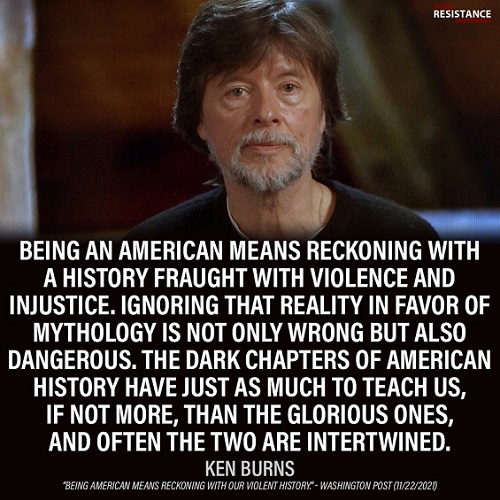
A Once-in-a-Century
Pandemic
We’re repeating a lot of the same mistakes from
the 1918 “Spanish Flu” H1N1 outbreak.
by Joyce Rice, Eleri Harris and Sarah Mirk
Posted on April 13, 2020
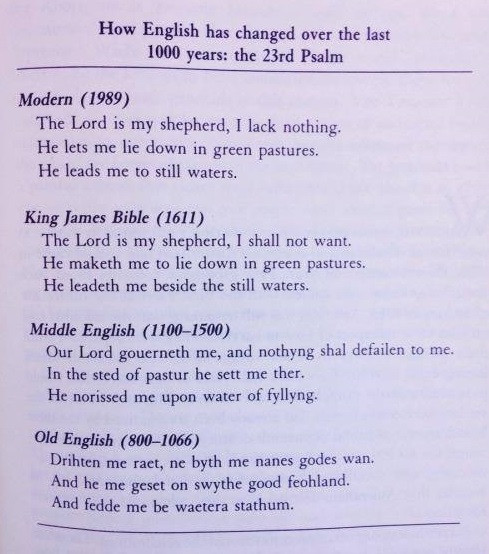
12
Marvelous Warrior Armor Ensembles from History
You Should Know About from Realm
of History
From 3,500 year old Bronze Age armor to Polish Winged Hussars
from the 1600s. Lavishly illustrated with descriptions of the armor.
Includes Aztecs, Japanese, Mongol, and Persian armor.
50
Viking-Age Sayings You Need to Know
from Medievalists.net
"Ever wondered what kinds of sayings and
expressions were
used in the Viking Age? The medieval sagas written in Iceland
capture a wealth of intriguing phrases that offer a glimpse into
Norse culture. Here, we present 50 of our favourite Viking-Age
sayings that reveal the wisdom and wit of the time."
3 examples:
“You wag your tongue like a fox waves his tail.”
~ Saga of Havard of Isafjord
“Many eyes squint when there’s money around.”
~ Bandamanna saga
“Tend the oak if you want to live under it.”
~ Egil’s Saga
Plus 47 more!
800th Anniversary of the Magna Carta was in 2015. "The charter first protected the rights and freedoms of society as well as establishing that the King was subject to the law rather than being above it." For example, the 39th clause of Magna Carta gives the right to a jury trial. "At its heart is the idea that the law is not simply the whim of the king, or the government. It is the great egalitarian legacy of Magna Carta, that all are equal under the law, and all can be held to account. It is that idea that gave birth to so many of our rights and freedoms, to parliamentary democracy, fair trial, and a series of controls on the abuse of arbitrary power." "It made us free."
![]()

According to Time Magazine (October 6, 2014 print issue), only
36% of Americans
can name all three branches of government. This is unacceptable!
The three branches of American government are Executive, Legislative, and
Judicial.
This goes for state governments as well as the federal government.
Therefore, GSFK presents some educational links on the subject:
No more excuses, people!
The Government
of Canada also has three branches with the same names as the USA's.
However, there are some noteworthy differences between the American
and Canadian arrangements.
The Australian
government also has the three branches. "Australia’s institutions
and practices
of government reflect British and North American models. At the same time,
they are uniquely
Australian...The Australian Constitution sets out the powers of government
in three separate
chapters—the legislature, the executive and the judiciary—but
insists that
members of the legislature must also be members of the executive.
In practice, parliament
delegates wide regulatory powers to the executive."
New
Zealand also has the three branches. "Our
system is based on the principle that power is
distributed across three branches of government — Parliament, the Executive,
and the Judiciary.
Parliament makes the law. The Executive (Ministers of the Crown also known
as the Government)
administers the law. The Judiciary interprets the law through the courts.
New Zealand has no single written constitution or any form of law
that is higher
than laws passed in Parliament."

Abraham Lincoln Research Site Valuable source since 1996! "I am not an author or an historian; rather I am a former American history teacher who enjoys researching Abraham Lincoln's life and accomplishments. If you have a specific Lincoln question that you would like me to research for you, please e-mail me. NOTE: The three main sections of this website are the Abraham Lincoln Research Site, Abraham Lincoln’s Assassination, and the Mary Todd Lincoln Research Site. For additional Lincoln information, please see my page titled Abraham Lincoln Links." Kudos to Roger Norton, Webmaster!
American Presidency Project at the University of California, Santa Barbara (UCSB). Amazing research tool! "The Papers of the Presidents. The American Presidency Project is the only online resource that has consolidated, coded, and organized into a single searchable database:
Their State of the Union Index has every State of the Union speech ever given since President Washington. .
Did you know that mrnussbaum.com has the most extensive United States history section for kids on the entire internet? Explore our nation's great activities and enjoy hundreds of interactive or printable activities by clicking on the painting above!
Animated Biographies from Mr. Nussbaum! "These animated biographies will bring the stories of famous Americans to life! Click on a story below to learn more. Please e-mail me to send feedback about these applications or to suggest subjects for future animated biographies." Biographies on Harriet Tubman, George Washington, Abraham Lincoln, Benjamin Franklin, Susan B. Anthony, and Christopher Columbus. More are sure to come!
The Arabia Steamboat Museum (Facebook page) The steamboat Arabia (web page) left Kansas City one day in 1856, carrying 200 tons of supplies for settlements upriver. She sank. Over 100 years later, the wreck was discovered, buried 40 feet deep in the middle of a cornfield! So 200 tons of pre-Civil War artifacts were recovered and is now in the museum. Silverware, dishes, pistols, tools, clothes, coffee, fabric, kettles, teapots, frying pans, glassware, nails, screws, bolts, baby dolls, hats, shoes, boots, watches, gunpowder flasks, watches.. This is the largest collection of pre-Civil War American artifacts in the world. It's just amazing. Here is one of their many videos.
Archiving Early America "Here at Archiving Early America, you will discover a wealth of resources — a unique array of primary source material from 18th Century America. Scenes and portraits from original newspapers, maps and writings come to life on your screen just as they appeared to this country's forebears more than two centuries ago." Excellent.
 Australian Explorers
"...these brave men opened up Australia to settlement and allowed the colony
to expand. In doing so, through their bravery, they wrote their names into the
history of Australia." The stories of brave men who walked or sailed all
over and around the continent of Australia, and sometimes died doing it. Horror,
adventure, tragedy, epic survival tales, and great achievements. "Primary
school children searching the Internet for information on Australian explorers
often have difficulty finding information suitable for their year level. Hopefully,
this page will provide them with an additional resource which they can access
for help with school projects." Not just for Australians anymore! Everyone
can learn something of Australia's history here.
Australian Explorers
"...these brave men opened up Australia to settlement and allowed the colony
to expand. In doing so, through their bravery, they wrote their names into the
history of Australia." The stories of brave men who walked or sailed all
over and around the continent of Australia, and sometimes died doing it. Horror,
adventure, tragedy, epic survival tales, and great achievements. "Primary
school children searching the Internet for information on Australian explorers
often have difficulty finding information suitable for their year level. Hopefully,
this page will provide them with an additional resource which they can access
for help with school projects." Not just for Australians anymore! Everyone
can learn something of Australia's history here.
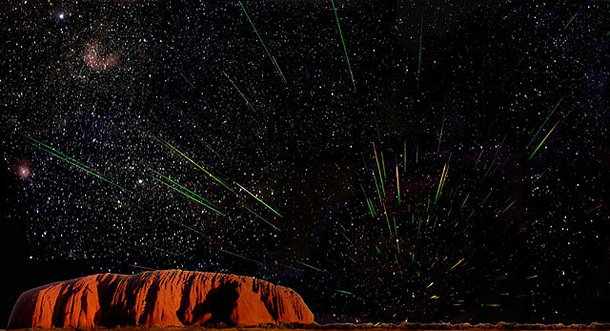 Australian History Timeline
"Featuring over 150 Film Clips showcasing a unique collection of Australian
history documentaries matched with selected websites from Australia's national
collecting institutions." Click Continue in the lower right corner of the
intro screen (the big green screen) to see the sites' matrix of decades. The
decade pages are packed with facts and photos. Click Search at upper right top
to search by People, Place, or Decade. This page also lets you access film clips,
related websites, and world events for each decade. Scroll across the decades
from left to right. All in all a very useful and entertaining resource.
Australian History Timeline
"Featuring over 150 Film Clips showcasing a unique collection of Australian
history documentaries matched with selected websites from Australia's national
collecting institutions." Click Continue in the lower right corner of the
intro screen (the big green screen) to see the sites' matrix of decades. The
decade pages are packed with facts and photos. Click Search at upper right top
to search by People, Place, or Decade. This page also lets you access film clips,
related websites, and world events for each decade. Scroll across the decades
from left to right. All in all a very useful and entertaining resource.
![]()
Daily Life of the Aztecs: A Blend of
Agriculture, Hierarchy, and Culture
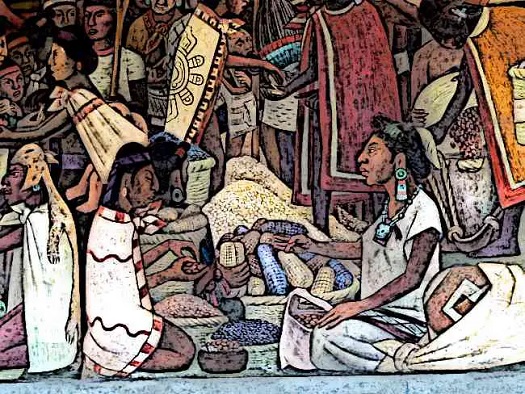
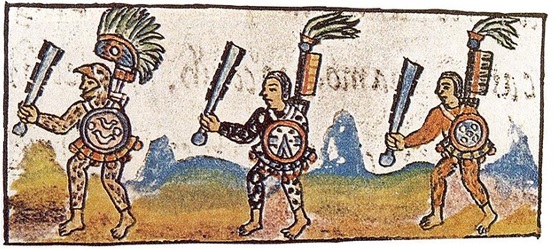
Here's a great article about the different parts
of Aztec civilization. Plenty of links to more
specialized pages. There is a great deal to
learn from these ancient people who built
a thriving society.
Going in History and Native Americans

Gifts
of the Buffalo Nation Learn about the North American
Buffalo
and their gift to the Indian Nations! By the Intertribal Bison
Cooperative, and the Wind
River Indian Reservation of the
Eastern Shoshone & Northern Arapaho.
This is a 31-page coloring book in pdf format, with plenty of
pictures to color and lots of facts about Bison!
The
Aztecs One of 27 similar activities from Snaith
Primary School. Good graphics. Learn all about the Aztecs! Then try out
the story starters, quizzes, printables, Sunstone Puzzle, and coloring pages!
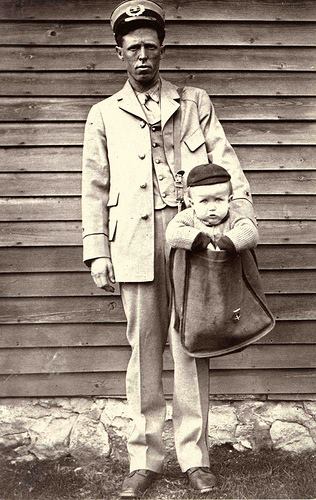
A Simpler Time
Until 1920, children could be mailed through the US Postal
Service! They had to be under 50 pounds, and stamps
were affixed to their clothes. It was cheaper for many
people to ship children than to put them on a train, and
the children rode on a train (in the mail car) anyway---
being watched and fed by mail clerks. The record distance?
Over 700 miles from Florida to Virginia for a mere 15 cents
in stamps. It really was "A Simpler Time"'.
(courtesy of the Wall St. Journal)
Battle
of Antietam September 17, 1862
.In the South this fight is known as the
Battle of Sharpsbur.
This important Civil War battle was (and still is) the bloodiest
one-day fight ever in North America. The results led President
Abraham Lincoln to issue
the Emancipation Proclamation.
This site from the Civil War Trust does a fine
job of discussing
the battle, and includes a good video (Antietam
Animated Map),
360° panoramas of the area, many articles, and links
to most
other Civil War battles.
Battle
of the Coral Sea 1942.
3 - 8 May 1942. May they Rest in Peace.
For reference:
CV = large ("Fleet") aircraft carrier
CVL = smaller fleet aircraft carrier, built on the hull of light cruisers, 9 built, 1 sunk.
CVE = small, convoy escort aircraft carrier ("jeeps"); built on the
hulls of merchant ships.
Maximum speed around 18 knots (21 mph, 33kph) About 250 were built. Most could carry
16 to 20 aircraft, usually torpedo bombers rigged with depth charge, and fighters to fight
enemy planes and ships. Some of the biggest "jeeps" (Kaiser builds) carrried upwards of
40 aircraft, including dive bombers.
BB = battleship (guns of 14" to 18" bore, lots of armour, and big). Older and slower ships
like USS Idaho still had good armor and decent guns. They were useful to bombard targets
during invasions. They had large numbers of antiaircraft guns to protect themselves and
other ships. The difference between these old ships and newer battleships was speed.
New ships, beginning with USS North Carolina, could make 28 knots or better, up to 33 knots.
CA = heavy cruiser (8" bore guns), armoured and fast
CL = light cruiser (5.5" to 6.1" guns, some older ones were small,
many newer ones were
big and fast)
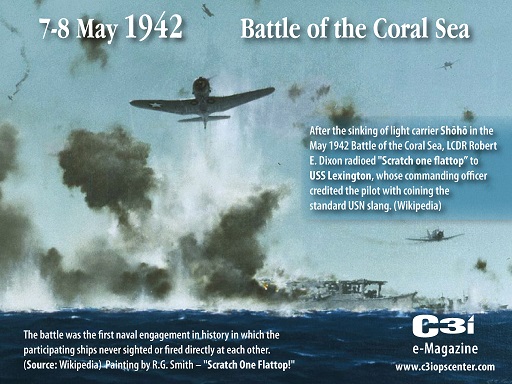
Early May, 1942. A scratch force
of American and Australian warships
assembles northeast of Australia to block the Japanese invasion of
Port Moresby, New Guinea. Port Moresby is the very last Allied air
and naval base north of Australia itself. It must be held.
The Japanese send a big troop convoy, escorted by warships and
a small aircraft carrier, to land troops at Port Moresby. The Allied
warships move to block the convoy's path.
This is heavy cruiser HMAS
Australia, one of the Allied ships.
"Lest We Forget".
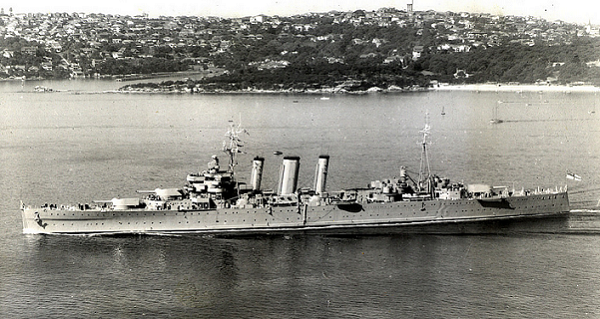
Another Japanese force of two big aircraft carriers ("fleet
carriers") and
more warships, are running interference to block any Allied warships and
sink them if they can. The Americans have two big carriers of their own,
out hunting for the Japanese. The battle lasts most of a week. The whole
fight is between aircraft carriers. None of the ships ever sees an enemy
ship. Both sides take heavy losses, but the Japanese retreat, and
Port Moresby is never taken by them.
Here is an excellent Australian account of the battle.
Here is a very detailed Wikipedia
article.
"Port Moresby was important because any Allied attack north through
New Guinea towards Rabaul required Port Moresby as a base. Similarly
for any attack south towards Australia, the Japanese required Port Moresby".
Results: USN loses the carrier Lexington. Lexington
is on fire for three
hours, but keeps flying off and recovering planes. Some of Lexington's
planes land on the Yorktown and are saved. Carrier Yorktown
is severely
damaged, but limps home to Pearl Harbor. Full repair will take six months,
but the dockyard has three days to patch her up before
the next battle.
The incredibly tough ship gets to Midway in time to join her sisters* in
the fight. *Enterprise and Hornet were identical to Yorktown.
Japan loses the small
carrier Shoho. The large carrier Shokaku's
flight
deck is smashed beyond repair. No planes can take off or land.
The other large carrier (Zuikaku) loses most
of its planes in the fight.
Allied navies would have moved all remaining planes to the one good
carrier, but that is not the Japanese way; so neither one will make it
to Midway.
There's more! Sinking
Of US Aircraft Carrier Lexington (1942)
Pathe newsreel.
Battle of the Coral Sea photo gallery from
The Australian.
Battle
of the Coral Sea Royal Australian Navy Official Site
Battle of the Coral Sea from the Australian Maritime Museum.
This site has big! loud! pictures! and a good running dialogue.
Battle of the Coral Sea from SlideShare A 54-slide show
in a Q&A format, for learners.
Battle of the Coral Sea
from BTN This is for the kids.
There's a 3:31 video to start, a Teacher section,
Rookie Reporter, and more. The best part
is the kids' Comments section,
no adults allowed!
If only the USA had something similar.
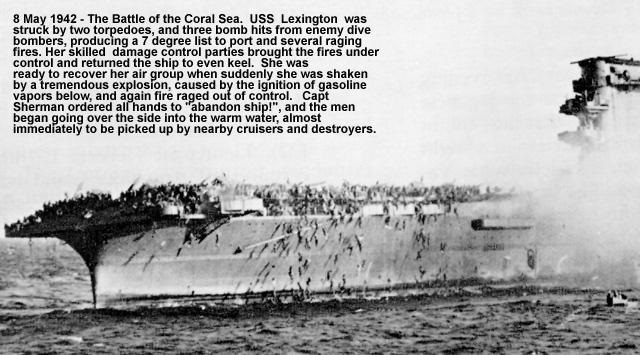
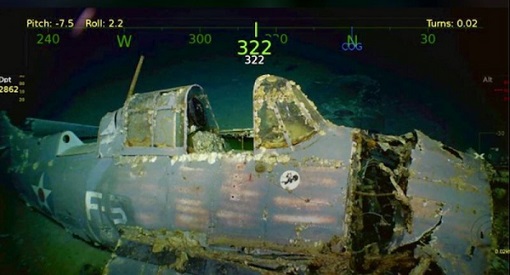
Here's a F4F Wildcat fighter from carrier Yorktown, with its "Felix
the Cat" logo,
found at the wreck of the Lexington. It landed on the wrong ship, we will never
know why. See where parts have been taken off to be used on another F4F?
This is an old and honored custom of "applied field logistics", called
cannibalization.
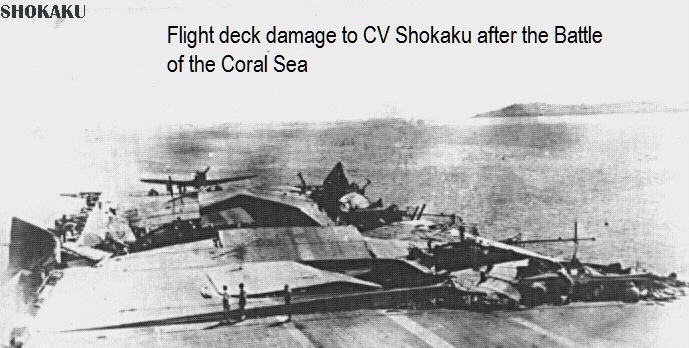
"Death of the Shoho"
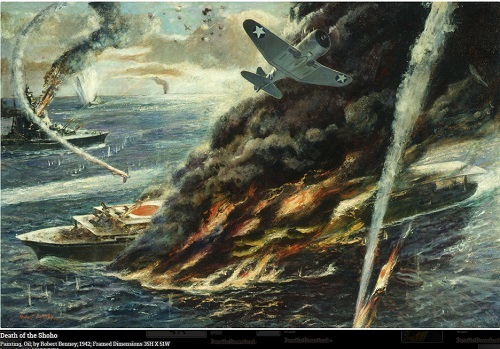
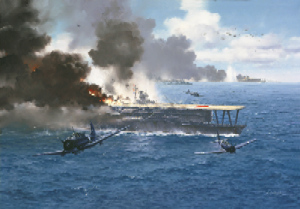 Battle
of Midway Learn about this pivotal battle of June, 1942, that decided World
War II in the Pacific, even though the fight went on for three more bitter years.
Special section about the sacrifice of the American torpedo-bomber squadrons,
and links to the US Navy collection of World War II art.
Battle
of Midway Learn about this pivotal battle of June, 1942, that decided World
War II in the Pacific, even though the fight went on for three more bitter years.
Special section about the sacrifice of the American torpedo-bomber squadrons,
and links to the US Navy collection of World War II art.
The Bayeux Tapestry from mrdonn.org.
It's part of their awesome Middle Ages for Kids section. Students will find out (a) what a tapestry is, (b) who made this tapestry, (c) why this tapestry is important, (d) what the tapestry tells us about this battle of 950 (about) years ago. There are also plenty of links to videos, activities, PowerPoints, graphics, etc., including the excellent video Bayeux Tapestry - Animated Version.
What if these 16th century ladies had never married Henry VIII?
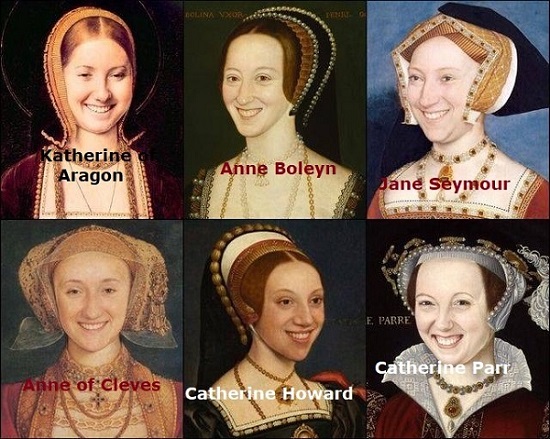
The Black Death Excellent one page lesson with graphics, from Mr.Dowling. They have a ton of lessons like this, to download for free!
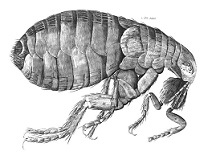 The
Black Death: Bubonic Plague from TheMiddleAges.net.
A one page summary with many links, including a relevant
excerpt from Boccaccio's The Decameron.
TheMiddleAges.net is
a big site, with plenty of links and information about various topics from the
time.
The
Black Death: Bubonic Plague from TheMiddleAges.net.
A one page summary with many links, including a relevant
excerpt from Boccaccio's The Decameron.
TheMiddleAges.net is
a big site, with plenty of links and information about various topics from the
time.
Blackfeet camp at night. Montana. 1800s. Glass lantern slide by
Walter McClintock.
Yale Collection of Western Americana, Beinecke Rare Book and Manuscript Library
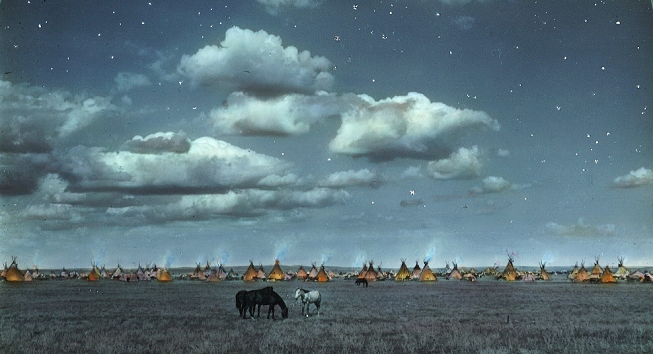
Blackfeet stampeding bison over a cliff, in the days before horses.
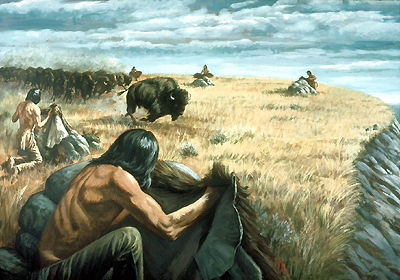
Buffalo (Bison) Education
from the
InterTribal Bison Cooperative . From the original people of the bison comes
this excellent educational resource. Learn the Traditional
Uses of the Buffalo with a comprehensive printable .pdf chart. Learn why
Buffalo Are Sacred. Learn buffalo
facts, the Historical and Cultural
Connection to the Buffalo and the awful Slaughter
of the Buffalo. Find out about buffalo Meat
& Nutrition, and recipes. Play the
Buffalo Brain Busters game. Color in the fact-filled Coloring
Pages for Kids.
Canterbury Tales Rap 1:52 video as shown on Getting Medieval "Oh yes. You heard me. If Geoffrey Chaucer lived today--and since he is my homeboy--he would surely be rapping his tales instead of putting them on parchment. Yo yo verily! Check it out! It is soooo great!" It's the first 27 lines of the General Prologue. Here's an Interlinear Translation, Middle English and Modern English.
Castles on the Web
"offers an extensive database of all things Castle related including a
castle photo gallery, free castle web pages, hundreds of castle links, castle
site of the day, castles for kids and more!" For our favorite trio of 10
year old castle fans, and millions more like them.
Photo
tour: The castles of Germany Photos of 54 German castles, including Neuschwanstein
Castle, Hohenzollern Castle, the Rhine castles, and more.
Leo Carter > Medieval England
Image: Joyeuse, the famous sword of Charlemagne,
on display in the Louvre, France
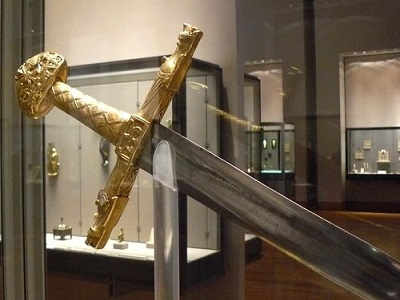
Here beginneth the mythlogy of this particular Magic Sword:
"According to tradition, the Joyeuse was Charlemagne’s personal
sword. It was forged by the famous blacksmith Galas, and took
three years to complete. The sword was described as having
magical powers, having been so bright that it could outshine
the sun and blind enemies in battle, and any person who
wielded it could not be poisoned.
One story tells of how Charlemagne once lost Joyeuse and
promised a great reward to whoever found it. One of his knights
returned it to the king who stuck it in the ground and declared
the lands around that spot to belong to the knight, which is the
origin of the French town of Joyeuse, founded on that spot and
named in honor of the sword.
There are also claims that the sword in the Louvre is much more
recent, in this case 12th century." That's the 1100s.
Charlemagne was born in 747? and died in 814. Soooo...
Charlemagne, AKA Carolus Magnus, Karl der Grosse, Charles the 1st;
Emperor of Rome, first Emperor of the Holy Roman Empire, King of
the Franks.
Charlemagne was a grandson of Charles Martel AKA The Hammer, the
Mayor of Paris, Mayordomo of the Royal Palace. In his job as commander
of the army, he destroyed the Muslim invasion of France at the Battle of Tours.
CHINA
IN CLASSROOM is a 46-page .pdf document
about Chinese culture, geography, history, and peoples.
It's provided by the Chinese
Consulate in Chicago.
Chinese Zodiac Why was 2016 the Year of the Metal/Red Monkey? How many animals are there, how many colors and elements? What is there a 60 year cycle and a 12 year cycle? Find out all about it this series of sites. Each animal in the zodiac gets its own long page of facts overload! At the bottom of each page is a list of all the animals in the zodiac. Each has its Chinese character and audio of how to say it in Chinese. Quite a resource!
Christmas in the Middle Ages "This feature looks at the origins of Christmas and how it was celebrated in the Middle Ages. It includes links to articles related to this topic." Three short videos discuss Origins, What went on at Christmas, Christmas Plays, Christmas Carols. Each has a short text of the same name. Excellent videos! There's also a section about Christmas trees, and some good links at the end.



Container ships. In the 1950s, shipping by sea was so complicated and expensive that most companies stayed away from it. The video, and its article and graphics, explains the origins of the container ship and how they drastically changed the world. "Containers can be transported by container ships, trucks, and freight trains as part of a single journey, without unpacking." - Wikipedia. Huge ships carrying hundreds of 40 foot sealed containers lowered the cost of shipping by about 90%. Now it was cheap to get goods to markets on the other side of the world. It was also cheap to buy imported goods. Therefore WalMart and other "big box" stores have mostly imported goods. Now everybody uses containers. Have a look at these monster ships!
Could you pass a US citizenship test? Here is a 96 question test covering what you would need to know in order to pass the citizenship test. OK, American citizens, let's see how you do! Useful for civics and government classes.
History of the Crusades: Origins, Politics, and Crusaders
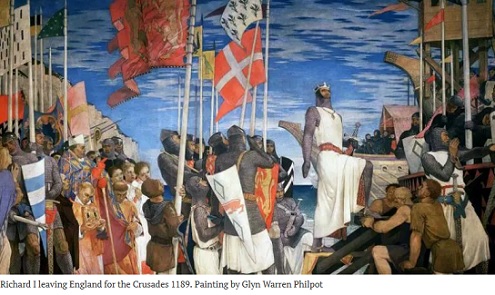
Secondary level illustrated article discusses the Crusades in
detail, all 9 to 12 of them, and not all went to the Holy Land.
Good in-depth information.
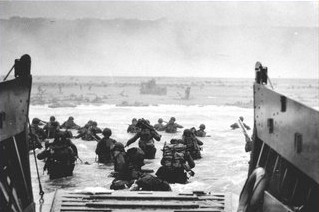
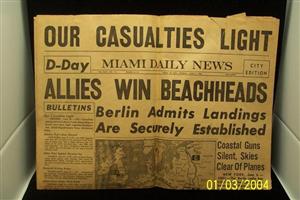
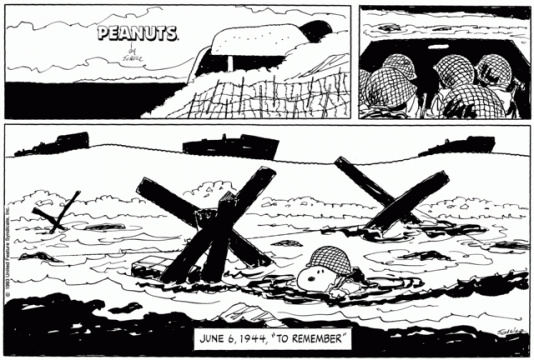
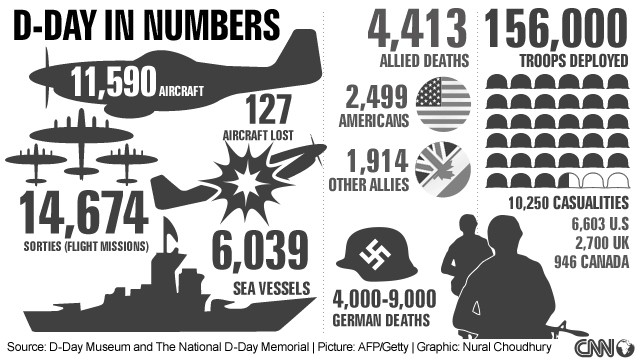
D-Day There are so many resources on the web about this pivotal event in world history, the Allied invasion of Normandy, June 6, 1944. This one is a very good resource from the BBC, with graphics.
The Doolittle Raid
Our page of links about this famous World War II incident.
Learn the history, learn about the heroes.
Ellis Island Americans - Learn about your ancestors at THE site to learn about immigration. Records of ships and people!
![]() Famous
Canadians "The infographic is a virtual Canadian Hall of Fame and showcases
influential Canadians who have contributed to scientific and social development,
economic security and prosperity, and the creative arts. The infographic was
designed to show visitors that Canada is home to great people who were visionaries
and history-makers." This very informative page is from CanadaFaq,
a site devoted to "Everything You Need to Know About Canada"; geography,
history, people, finance, education, economy, immigrating, jobs, etc. Kudos
to Vera Johnes at CanadaFaq, for the
email telling us about this fine web site.
Famous
Canadians "The infographic is a virtual Canadian Hall of Fame and showcases
influential Canadians who have contributed to scientific and social development,
economic security and prosperity, and the creative arts. The infographic was
designed to show visitors that Canada is home to great people who were visionaries
and history-makers." This very informative page is from CanadaFaq,
a site devoted to "Everything You Need to Know About Canada"; geography,
history, people, finance, education, economy, immigrating, jobs, etc. Kudos
to Vera Johnes at CanadaFaq, for the
email telling us about this fine web site.
![]() Frontier
Culture Museum of Virginia "tells the story of the thousands of people
who migrated to colonial America, and of the life they created here for themselves
and their descendants. Many were farmers and rural craftsmen set in motion by
changing conditions in their homelands, and drawn to the American colonies by
opportunities for a better life. Others came as unwilling captives to work on
farms and plantations." The Exhibits show typical buildings from each ethnic
group and a page of facts for each group.
Frontier
Culture Museum of Virginia "tells the story of the thousands of people
who migrated to colonial America, and of the life they created here for themselves
and their descendants. Many were farmers and rural craftsmen set in motion by
changing conditions in their homelands, and drawn to the American colonies by
opportunities for a better life. Others came as unwilling captives to work on
farms and plantations." The Exhibits show typical buildings from each ethnic
group and a page of facts for each group.
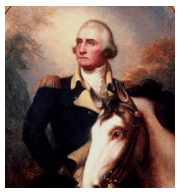 George
Washington Quotes from Notable
Quotes. Nine pages of quotes, around 25 to a page. Also has a good biography
and a trivia quiz. Great for American history among other things. The man wrote
quite well and he knew his grammar.
George
Washington Quotes from Notable
Quotes. Nine pages of quotes, around 25 to a page. Also has a good biography
and a trivia quiz. Great for American history among other things. The man wrote
quite well and he knew his grammar.
Get Interactive: Teach the Middle Ages for Ages 5 to 25 Lesson ideas for everything from drawing monsters, storytelling, story writing, drawing maps, skits, cooking, crops, city planning, and more. "A list of activities, discussions, and assignments to support teaching the Middle Ages. Many of these suggestions can be adjusted for different ages, but I’ve arranged them in a roughly age-progressive order. For more great ideas and specific grade-level lesson plans contributed by others, check out this page. Happy teaching!"
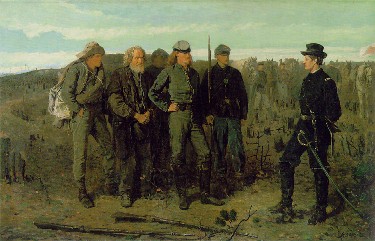 Painting
by Winslow Homer: " Prisoners at the Front" (1863).
Union Brigadier General Francis C. Barlow talks with Confederate prisoners of
war at Gettysburg. Badly wounded several times, Barlow ended the war as a Major
General. Later in life, as Attorney General of the State of New York, Barlow
successfully prosecuted Boss Tweed and broke the Tammany Hall gang.
Painting
by Winslow Homer: " Prisoners at the Front" (1863).
Union Brigadier General Francis C. Barlow talks with Confederate prisoners of
war at Gettysburg. Badly wounded several times, Barlow ended the war as a Major
General. Later in life, as Attorney General of the State of New York, Barlow
successfully prosecuted Boss Tweed and broke the Tammany Hall gang.
A famous American painter, Winslow Homer was a combat artist during the war. This is one of many paintings that he drew from sketches he made during the action.
A note about American Civil War battle names: Some names differ from North to South. 1st and 2nd Bull Run (the creek) are called 1st and 2nd Manassas (nearby town) in the South. Same for Antietam (the creek), called Sharpsburg (nearby town) in the South.
Gettysburg
Civil War site for kids, from the National Park Service. Investigates the causes
of the war and the larger conflict, too.
Gifts
of the buffalo. This graphic lists many of the gifts.
Not everything is listed, but the People used everything.
Waste not, want not.
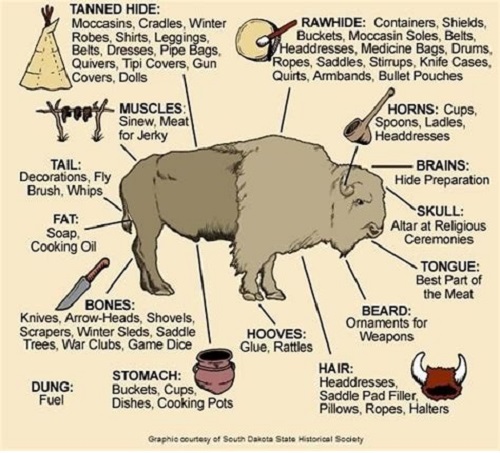
Go Social Studies Go is now
History Cat. "History Cat integrates fun content with the coolest links, videos, and games found on the net. In addition, we’ve teamed with with Cramstoppers, a free quiz making site that allows students to take their education one step further. " This site constantly adds new things to read and do. American and World History, World Geography, Global Religions, Choose Your Own Adventure, links, more. Oodles of subcategories in each! We ran on the Underground Railroad, read about Archduke Ferdinand's assassination, checked out the Silk Road, learned about African geography ("Place is huge!"). This is middle school through high school level, maybe first year college - anyway, excellent site! Shout out to "veteran social studies teacher" Ken Uhde, of Groves High School, Birmingham, Michigan, its creator!
The Gothenberg
is a 2003 replica of a Swedish East Indiaman.
East Indiamen were long range, high-capacity merchantmen
(trading ships). The original the original Götheborg was lost
in 1745. The replica has two Volvo diesel engines and propellers
From the 1600s into the 1800s, all the seafaring nations of Europe
used ships like this to trade with India and the Far East.
Götheborg is a sailing replica of an 18th-century Swedish East Indiaman
and one of the world's largest operational wooden sailing vessels.
Ten tons of hemp ropes were used for rigging the vessel, together
with some 1,000 wooden blocks and 1,964 m2 (21,140 sq ft) linen sail.
All this was produced using 18th century techniques.
This is not a model, it is the same size as the original.
"One small change was that the headroom of the deck was increased
by 10 cm, since today's seamen are taller than their ancestors."
#history of trade
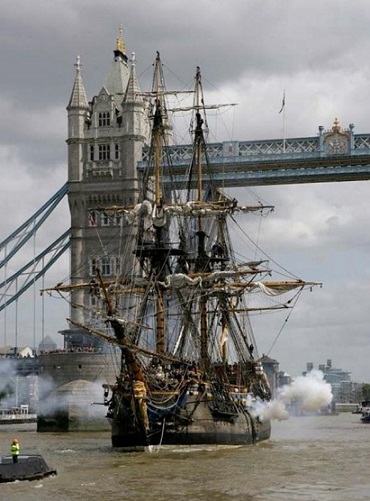
The
Gunpowder Plot
Guy Fawkes Day
and Bonfire Night
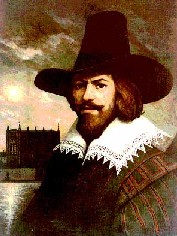
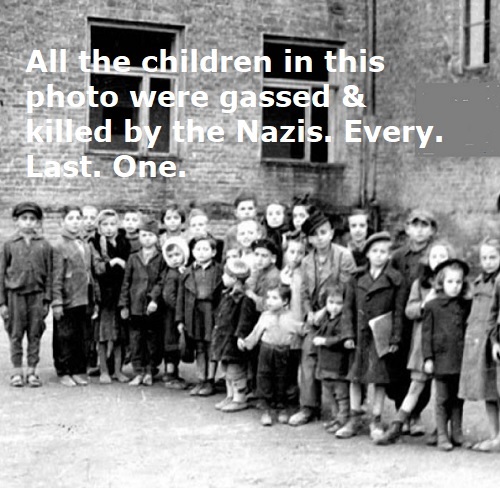
Look up Maidenek, Holocaust
![]()

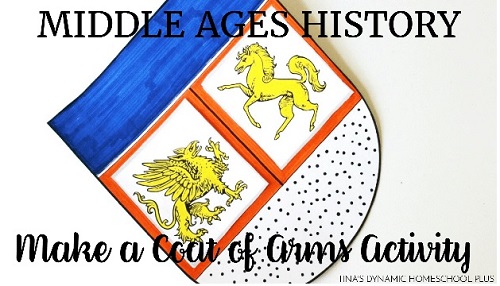
Hands-On
History: Make a Coat of Arms Activity (Middle Ages History)
In those years (and in the years since), royal and noble families have had a
coat of arms to show what they’ve accomplished in their history.
To learn more about how these designs were used and passed down through
families, we decided to make our own coat of arms!
See how you can do the same for a hands-on history lesson!"
Historical Atlas of Europe from Year 1 to 2000 ..."shows the history of Europe through a sequence of 21 historical maps, every map depicting the political situation at the end of each century." Great history resource.
![]() The
History and Future of Everything -- Time a video from Kurzgesagt
"Videos about Science, made with Love. We are a team of Information Designers
and Motion Designers that specialize in the art of explaining stuff." This
video gives kids a better understanding of time and history in proportion. Fine
graphics, nice music, wonderful narration. They have (as of now) five more videos,
from evolution to the stock market.
The
History and Future of Everything -- Time a video from Kurzgesagt
"Videos about Science, made with Love. We are a team of Information Designers
and Motion Designers that specialize in the art of explaining stuff." This
video gives kids a better understanding of time and history in proportion. Fine
graphics, nice music, wonderful narration. They have (as of now) five more videos,
from evolution to the stock market.
History of Labor Day From the US Department of Labor. Find out the history of the holiday, learn why it is more than just another Monday off.
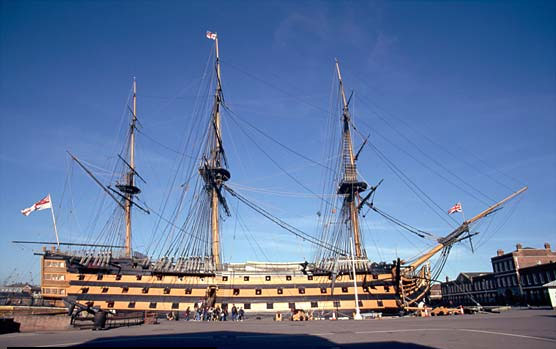 HMS Victory
official site. Learn about the world's oldest warship, in service since 1765!
The only surviving "First Rate" wooden battleship in the world, HMS
Victory was Lord Nelson's flagship at the Battle of Trafalgar back in 1805,
and is still on duty with the Royal Navy today! Use the menu across the
top of the screen. Interactive views of different decks. Photos of the interior
and famous paintings. The various stats would be good for mathematics classes.
HMS Victory
official site. Learn about the world's oldest warship, in service since 1765!
The only surviving "First Rate" wooden battleship in the world, HMS
Victory was Lord Nelson's flagship at the Battle of Trafalgar back in 1805,
and is still on duty with the Royal Navy today! Use the menu across the
top of the screen. Interactive views of different decks. Photos of the interior
and famous paintings. The various stats would be good for mathematics classes.
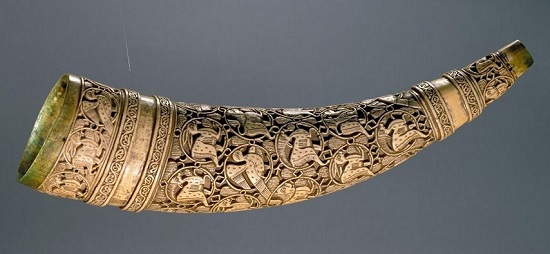
This exquisite hand carved ivory horn was made by Muslim artists in Sicily. The Emirate of Sicily ruled Sicily from the 800s,
after chasing the Byzantines out. In 1071, Norman adventurers conquered southern Italy, Sicily, and Malta. They liked the carved ivory horns like the one above
and patronized all the arts. Count Roger I of Sicily
owned this horn.
How an 18th
Century Sailing Battleship Worked
25 minute YouTube video.
"Fly through a wooden warship from the age of sail!"
Explore all the decks in detail. Learn about the complicated
ropes, sails, and rigging. See the different types of guns
and shells. Some of those ships held 1,000 men, and
everything was highly organized.
It is amazing what humans can make, within
the constraints of their current technology.

5:35 NatGeo video explains why clean water and sewer
are and were essential for people living in large, crowded
cities and everywhere else.
How
Magellan circumnavigated the globe A six minute TED-Ed YouTube video. Learn
how Ferdinand Magellan,
with five Spanish ships, set off to sail around South America, crossed the Pacific
from east to west, found the Spice Islands, loaded up precious cargo, and sail
back to Spain. One ship made it back, but Magellan didn't. It was all about
the money from the spices.
This animated map shows how humans migrated across the globe. From Business Insider. "It's tough to know what happened on Earth thousands of years before anyone started writing anything down. But thanks to the amazing work of anthropologists and paleontologists like those working on National Geographic's Genographic Project, we can begin to piece together the story of our ancestors. Here's how early humans spread from East Africa all around the world."
I Was Wondering.org Introducing women's adventures in science! Bios and timeline of 25 women scientists who have made this a better world. Ten of them their own pages on this site! There are games and an Ask It section for your questions. Girls can too do science! Thanks, Terri.
(The) Ice Trade In this history game set in the 1800s, students send 10 ships loaded with ice from New England to Florida, Brazil, or India. Can you turn a profit in 10 turns?
1963 - "Lest we forget."
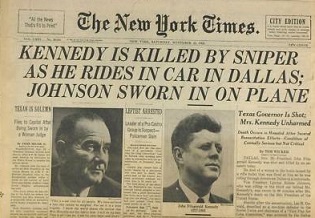
Jamestown Settlement "In 1607, 13 years before the Pilgrims landed in Massachusetts, a group of 104 English men and boys began a settlement on the banks of Virginia's James River..." Well done site explores the history, the different peoples - native, European, and African - and the world of 1607. The YouTube videos greatly enhance learning.
Kathi Mitchell's Civil War links. A big list of links to sites about the American Civil War, 1861-65. A good place to go for links.
Kathi Mitchell's Social Studies links A big collection of links to sites, arranged in sections. Her list of Native American links is superb!
![]() Khan Academy "is a not-for-profit
501(c)(3) with the mission of providing a world-class education to anyone, anywhere...We
are complementing Salman (Khan's) ever-growing library with user-paced exercises--developed
as an open source project--allowing the Khan Academy to become the free classroom
for the World." 1800+ videos cover math from 1 + 1 up through differential
equations; Science: Biology, Chemistry, Physics, Organic Chem, Cosmology, Astronomy;
History; Finance (BIG section!); Test
Preps for: SAT, GMAT, CAHSEE, IIT JEE. The videos are wonderful! This is amazing
and FREE!
Khan Academy "is a not-for-profit
501(c)(3) with the mission of providing a world-class education to anyone, anywhere...We
are complementing Salman (Khan's) ever-growing library with user-paced exercises--developed
as an open source project--allowing the Khan Academy to become the free classroom
for the World." 1800+ videos cover math from 1 + 1 up through differential
equations; Science: Biology, Chemistry, Physics, Organic Chem, Cosmology, Astronomy;
History; Finance (BIG section!); Test
Preps for: SAT, GMAT, CAHSEE, IIT JEE. The videos are wonderful! This is amazing
and FREE!
Kids Past from KidsKnowIt. "KidPast.com is the fun way to explore our history. We are who we are today, because of those who have gone before us. " The Online History Textbook does a good job of covering elementary and middle school history. The History Games are pretty good. The Historical Quotes are over the top, and every child should know about them.
Kids' View of World War II and the 1940s Era from the Spring Hill Elementary School in Kansas, this older site (2000-2001) works to bring the World War II era to life for contemporary kids. Made by 5th graders and their teachers. Interviews with veterans and civilians alike brings a unique touch. Also covers fashions, entertainment, toys and games, and has a timeline. Thanks, Mrs. Vopat and Mrs. Jones, and the Jr. Ikes Teams.
KidsKonnect
Civil War links. More links to sites about the
American Civil War, 1861-65. Good page layout sets the mood.
The Kokoda track was the setting for a famous event in Australian
history, one which still resonates in the national consciousness today...
Why is the Kokoda track significant?
"Port Moresby was important because any Allied attack north through New
Guinea towards Rabaul required Port Moresby as a base. Similarly for any attack
south towards Australia, the Japanese required Port Moresby as a base."
The Kokoda track stands as an
icon for Australian participation in World War II just as Gallipoli
does for World War I...
Japanese forces took over the Solomon Islands, New Britain, New Ireland, and
the north shore of New Guinea. They captured the big Allied base at Rabual on
New Britain. After the Coral Sea battle, Japan decided to take Port Moresby
by land. This meant marching south across the island of New Guinea from sea
to sea; up from the north shore, south through the jungle, over 11,000 feet/3,350m
mountains, through deep canyons and steep ridges, to the south shore and Port
Moresby. They had to carry all their supplies on their backs. Food, ammunition,
medical supplies, tents, shovels, radios, everything.
The Australians had to do the same, but they also had the
Owen gun,
a very reliable 9MM weapon invented by an Australian teen in his garage.
it was used for nearly 50 years! "Simply the best."
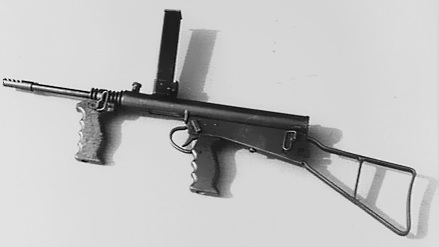
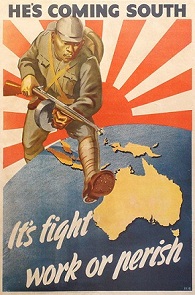 The
regular, veteran Australian soldiers were off fighting in faraway North Africa;
or had already been captured by the Japanese in the Dutch East Indies, Malaya,
or Singapore.
The
regular, veteran Australian soldiers were off fighting in faraway North Africa;
or had already been captured by the Japanese in the Dutch East Indies, Malaya,
or Singapore.
The Australians called up volunteers and reserve units of untrained men with old gear and leftover weapons. The Japanese had artillery (75MM "mountain guns") and the Australians had none. The Australians fought, lost, and fell back south. This happened several times. Japanese Army units got within sight of Port Moresby when they stopped their southward advance at Ioribaiwa Ridge. They were 40 Km/24 miles from their goal. Imperial Army HQ ordered the halt because: (1) The game and stubborn Australians were falling back much too slowly to suit them, and (2) US Marines had landed on Guadalcanal and were destroying Japanese units sent to stop them. Japanese Army HQ decided to go after the Marines first and then to push on to Port Moresby. "Senior Japanese officers interviewed after the war thought that the factor most influencing the postponement was not Guadalcanal but rather 'stronger than anticipated' Australian resistance at Kokoda."
Besides, the Japanese did not believe that the Americans could
hold onto Guadalcanal for very long.
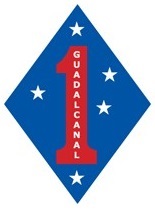 (But they were wrong, weren't they?)
(But they were wrong, weren't they?) 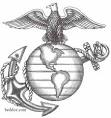
The Allies used this halt in the PNG fighting to bring Australian veteran units back from North Africa; and to send in American troops, aircraft, and more ships. This time, the Allies had more aircraft, organization, and artillery. It was the Japanese Army's turn to get pushed back, all the way to the north shore.
Every sub-topic has an education section titled "Teaching and Learning Activities for the Classroom." These are challenging, pre-made lessons for students, designed to get them acquainted with the history. They are very good. The Animated Battle Maps show every move each side made.
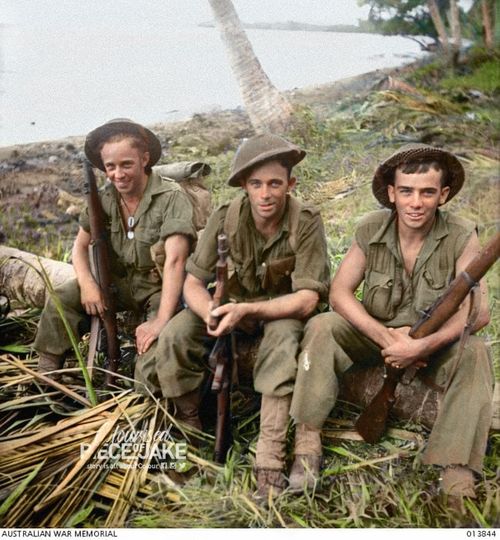
"16 December 1942. Gona. The three Chapman brothers from
Moonta in South Australia, who all joined the 2/27th Infantry.
The siblings are pictured pausing during a break in fighting
against the Japanese just after the fall of Gona."
[on the north coast at the northern end of the Track]
"The lads, the sons of Maurice and Mabel Chapman, all survived
the war but an elder brother, Lance Chapman, 25 was killed in
Egypt six weeks before this photo was taken.
Left to right: SX12357 Private Maxwell Maurice Chapman;
SX12689 Private Desmond Chapman; and
SX10196 Private Raymond Chapman.
They were lucky and all survived the war."
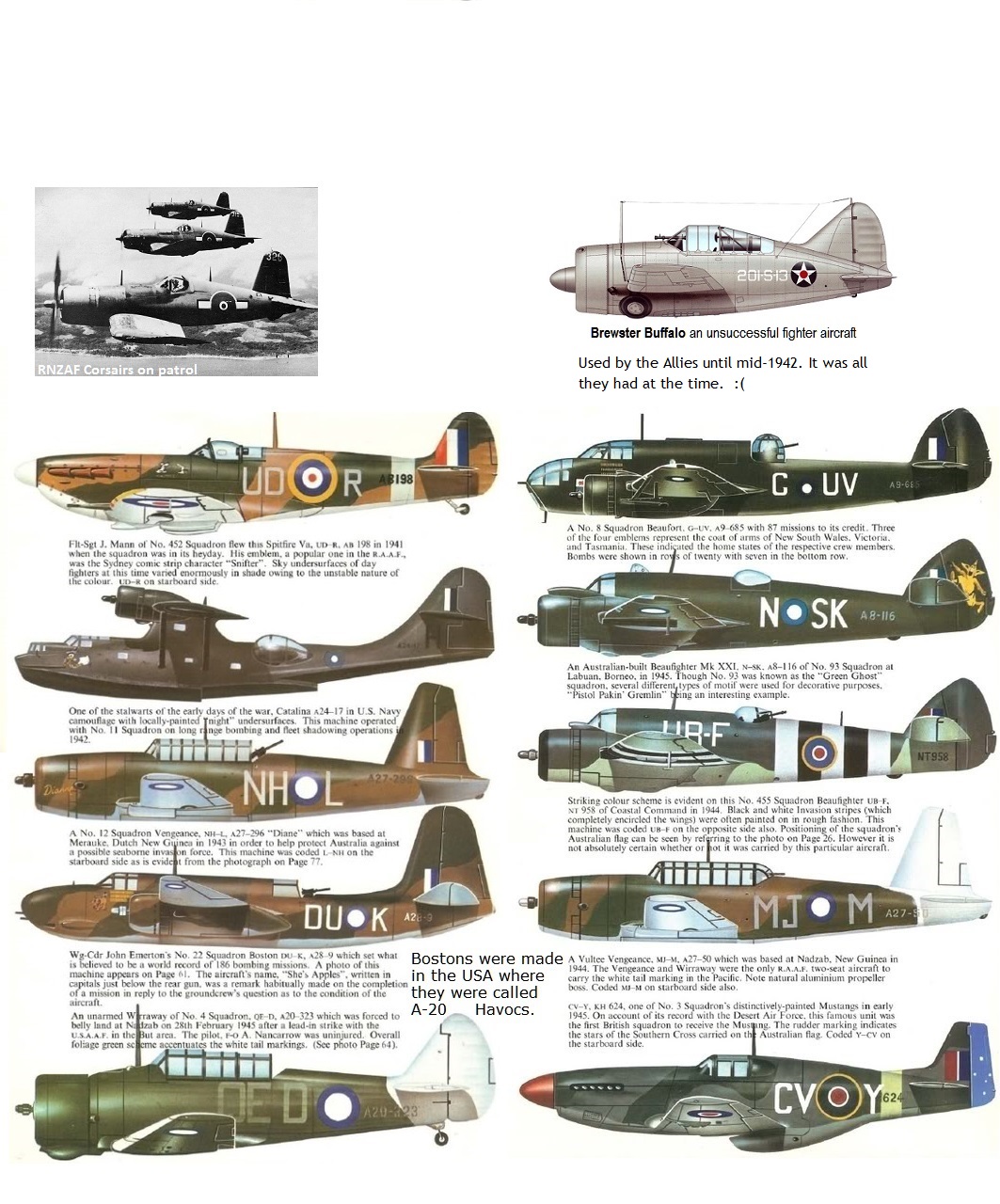
![]()
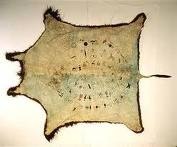 Lakota
Winter Counts - An online exhibit from the Smithsonian. Who are the Lakota?
What's a Winter Count? Who made them? What art media were used? Listen to Lakota
elders explain the records of the years. See surviving winter counts from as
far back as 1701. The gallery of winter counts is awesome. (To scroll right
or left, put your mouse arrow in the upper left or upper right side of the picture.)
Bonus: Native speaker pronounces Lakota words for you! Click on the tiny white
words "Audio Glossary" that are underneath the main site.
Lakota
Winter Counts - An online exhibit from the Smithsonian. Who are the Lakota?
What's a Winter Count? Who made them? What art media were used? Listen to Lakota
elders explain the records of the years. See surviving winter counts from as
far back as 1701. The gallery of winter counts is awesome. (To scroll right
or left, put your mouse arrow in the upper left or upper right side of the picture.)
Bonus: Native speaker pronounces Lakota words for you! Click on the tiny white
words "Audio Glossary" that are underneath the main site.

Sirius at Wikipedia plus an X-ray photo of Sirius-a with Sirius-b peeking over its shoulder.
Let's Get 'Sirius' About the Dog Star, Sky's Brightest Twinkler from Indian Country Today Media Network. Facts about Sirius, but mostly tells how the star was regarded in Native American/First Nations cultures and in the myths of various tribal nations. Very good reading. If you don't see the star's photo on their site, click on the graphic.
Lewis and Clark- The PBS site. Includes teacher resources.
National Geographic's Lewis and Clark site, with interactive map. NatGeo also has an (even more) kid-focused L & C site.
Liberty! Includes the Road to Revolution activity. From PBS.
Liberty's Kids! Great companion site for the TV series shown on PBS.
![]()
Can you pass this "literacy test" people of color had to take to vote?
"The website of the
Civil Rights Movement Veterans, which collects materials
related to civil rights, hosts a few samples of actual literacy tests used in
Alabama, Louisiana, and Mississippi during the 1950s and 1960s. People working
within the movement collected these in order to use them in voter education,
which is how we ended up with this documentary evidence." Thanks, Slate
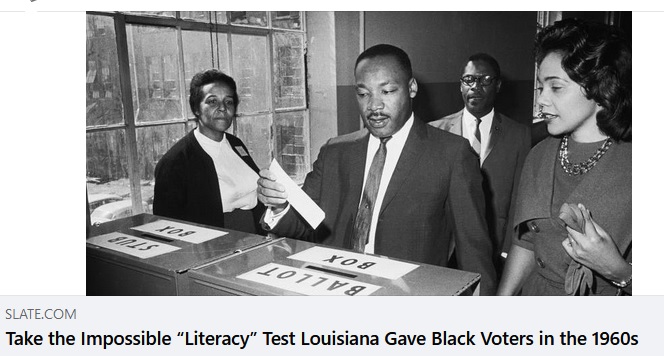
Designed to put the applicant through mental contortions, the test’s questions
are often confusingly worded. If some of them seem unanswerable, that effect
was intentional. The (white) registrar would be the ultimate judge of whether
an answer was correct.
Try this one: “Write every other word in this first line and print
every third word
in same line (original type smaller and first line ended at comma) but capitalize
the fifth word that you write.”
Click the picture to learn more about the Underground Railroad
to Mexico!
More links:
“Determined
to Make His Way to Mexico”
Mexico: Haven For Fugitive Slaves
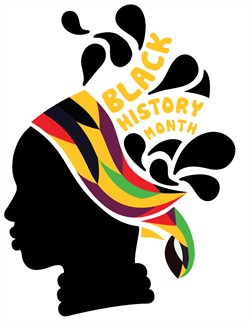 Black
History Month from Chiff.com. Comprehensive explanation of BHM, with links
to bios of famous Afro-Americans
Black
History Month from Chiff.com. Comprehensive explanation of BHM, with links
to bios of famous Afro-Americans
Martin Luther King, Jr. Research and Education Institute of Stanford University. Arguably the best MLK resource site, this one has everything.
Martin Luther King Speeches - Excerpts from King's most famous addresses. From infoplease
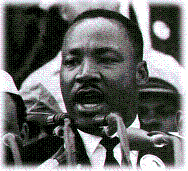 "I
Have a Dream" speech, text and audio, from American
Rhetoric .
"I
Have a Dream" speech, text and audio, from American
Rhetoric .
"I've Been to the Mountaintop" speech, text and audio, from American Rhetoric .
Here are three links to information about Rosa Parks
Biography for kids from Ducksters (great series of sites, BTW)
Rosa Parks from Wikipedia - harder for kids to read, good
Remembering Rosa Parks on Her 100th Birthday Excellent bio video from Biography.com.
The Montgomery Bus Boycott - a BBC video on YouTube 7:13 long. Pretty much sums up how things were.
Mavis Staples "Eyes On The Prize" - Similar video with a song from the era. Racial violence is shown.
Mavis Staples - "Down In Mississippi" - Blues video - actually an oral history - describes growing up black and female in the bad old days. Also praises Dr. King.
Remembering ‘Red Summer,’
when white mobs massacred
Blacks from Tulsa to D.C., 1919-1923
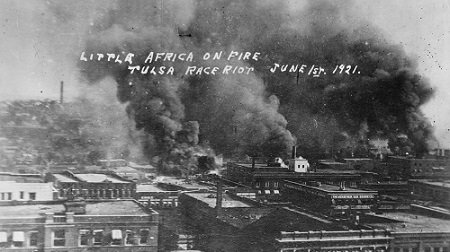
Bonus: History.com 's article
on the Tulsa Massacre.
“It was an intentional use of violence against African Americans.
The motivation was to punish African Americans for economic
success and take it away. In Tulsa, they burned it to the ground.”
"Fire and fury fueled massacres in at least 26 cities, including
Washington, D.C.; Chicago; Omaha; Elaine, Arkansas;
Charleston, South Carolina; Columbia, Tennessee; Houston;
and Tulsa, Oklahoma."
“During the massacres, they murdered and maimed people
indiscriminately, unprovoked. They went into homes, stole
personal belongings, and burned down homes. They used the
massacres as a cover to murder without sanction, maim without
sanction, and steal without sanction. No one, to this day,
has been held accountable.” WARNING: Not for younger students.
Secondary only. Graphic photos and text.
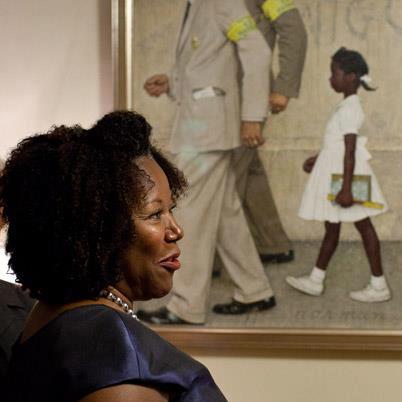 Ruby
Bridges from Biography.com. "Ruby Bridges was born on September 8,
1954, in Tylertown, Mississippi. In 1960, when she was 6 years old, her parents
responded to a call from the National Association for the Advancement of Colored
People, and volunteered her to participate in the integration of the New Orleans
school system. Bridges is best known as the first African-American child to
attend an all-white elementary school in the South." This bio site features
a video of President Obama and Ruby Bridges discussing the events shown in this
famous Norman Rockwell painting. There is a four page biography, and plenty
of links to other Black History and Civil Rights sites.
Ruby
Bridges from Biography.com. "Ruby Bridges was born on September 8,
1954, in Tylertown, Mississippi. In 1960, when she was 6 years old, her parents
responded to a call from the National Association for the Advancement of Colored
People, and volunteered her to participate in the integration of the New Orleans
school system. Bridges is best known as the first African-American child to
attend an all-white elementary school in the South." This bio site features
a video of President Obama and Ruby Bridges discussing the events shown in this
famous Norman Rockwell painting. There is a four page biography, and plenty
of links to other Black History and Civil Rights sites.
United States Black History Month Coloring Pages from Daily Coloring Pages. Lots of printable coloring pages of famous black Americans, including brief bios.
End Black History Section (but the struggle goes on!)
![]()
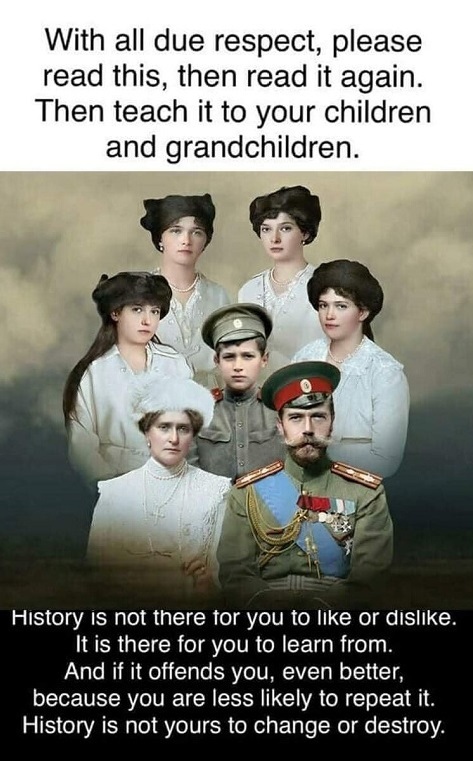
To learn more, look up Nicholas II, Russian Revolution.
Medieval
Map "This website illustrates the historical changes that occurred
in the Medieval Era (400 - 1500) with an interactive map." Understatement!
Move back and forth through time in 10 to 50 year intervals. Click on one button
to show cities, another to show decisive battles. Click the ? button to see
a modern map. For battles, there is a brief synopsis in a popup window, with
the option to go to Wikipedia. Clicking on a city icon sends you directly to
Wikipedia. The map shows all the contemporary peoples and states for the period
you choose. Clicking on any label (example: "Balts") brings up a three-section
pie graph. One section - the "W", sends you to Wikipedia. Clicking
the folder" icon opens up a book or article, if there is one (in this case
an e-book called "The Balts", by Marija Gimbutas). Clicking on the
"film" icon will open a video, if there is one. The site is constantly
being improved. It's quite a trip through time for middle school and older.
Visual learners may finally grasp the idea of huge groups of peoples moving
across Europe. See empires and kingdoms rise and disappear. Wonder at the names
of people and places: Umayyads, White Huns, Polotsk, Navarre, Swabia, Trebizond,
the Obotrites, Jomsvikings, Erik Blood-Axe, Attila the Hun, Harald Bluetooth,
the Bulgars, Sven Fork-Beard, Harald Hard-Advice, Charles the Hammer, and all
the rest.
In honor of National Hispanic Heritage Month,
Here are some facts about the Battle of Puebla in 1862.
Mexican infantry:

1. State Militiaman 1863-67
2. Infantry Private 1866-67
3. Infantry Private Supemos Poderes
(Supreme Powers) Batallion
Mexican cavalry:

1. Trooper, Rurales 1862-63
2. Irregular cavalryman 1866-67
3. Trooper, Line (regular) cavalry
Mexican cavalry after the battle, men
and horses exhausted but victorious.

Here are a couple of related online games
from Seterra:
South America: Countries - Map Quiz Game
North and Central America: Countries
Mission US "An interactive way to learn history." An RPG. "Mission US is a multimedia project that immerses players in U.S. history content through free interactive games." There are four games at this time:
Moundbuilders
Teacher's Guide for Native American Heritage Month. From the American Indian
Cultural Center and Museum (AICCM) of Oklahoma. Excellent self-contained teaching
unit ready to go! Amazing art, artifacts, in-depth discussion of various moundbuilding
Native American cultures over 11,000 years, from prehistoric times to the 1500s.
Lots and lots of art! Plenty of activities.
Mount Rushmore National Memorial This is a multimedia site from CyArk. It is fantastic. This presentation starts with a slideshow. Other sections off of the horizontally scrolling main section cover the Black Hills, Gutzom Borglum, carving the sculpture, preservation, how CyArk digitally documented the Memorial for posterity, laser scanning, photography, the Virtual Tour, videos (including the Tom Brokaw intro that you watch at the Memorial), and 2D & 3D perspectives. Marvelous job. Our fave is the very cool Virtual Tour, showing everywhere you can go. If you cannot visit Rushmore then this is the way to go! Visualize someone taking the virtual tour while standing on the same spot!
National Archives "The National Archives and Records Administration (NARA) is the nation's record keeper. Of all documents and materials created in the course of business conducted by the United States Federal government, only 1%-3% are so important for legal or historical reasons that they are kept by us forever... Those valuable records are preserved and are available to you, whether you want to see if they contain clues about your family’s history, need to prove a veteran’s military service, or are researching an historical topic that interests you." This is a treasure trove of original, primary source documents. Click here to research records. Click here to look for Veterans Service Records and other military. Click here to see Teachers' Resources. The Declaration of Independence, the Constitution, Emancipation Proclamation, Civil War records, World War 2, FBI, CIA, and OSS films on DVD, military service records, it is all there. They also have branches all over the US.
 National
Student Mock Election "Welcome to the nation’s largest civic
education project. Student voice is an essential part of a vital and vibrant
society. That’s why the My Voice™ National Student Mock Election
aspires to create more paths for young people to express their views and participate
in the democratic process. Join this historic initiative because It’s
Your Democracy." Teachers can enroll their class(es), view demos, and get
ready to vote!
National
Student Mock Election "Welcome to the nation’s largest civic
education project. Student voice is an essential part of a vital and vibrant
society. That’s why the My Voice™ National Student Mock Election
aspires to create more paths for young people to express their views and participate
in the democratic process. Join this historic initiative because It’s
Your Democracy." Teachers can enroll their class(es), view demos, and get
ready to vote!
Native Americans and the U.S. Military Gives the history of Native Americans in all branches of service during the past century. Also lists the eight Native American Medal of Honor winners from World Wars I and II, Korea, and Vietnam. Information about Code Talkers of different nations.
Native Americans in the US Army Lots of links, videos, biographies, a Comanche Code Talker, and more. Includes Willing to Serve, a cross section of Native veterans and active-duty.
Native Americans in the US Navy Primarily about World War II, Korea, and Vietnam. Biographies of famous Native sailors, including Commander Ernest Edwin Evans, USN, Medal of Honor, WW II. Also a nice PowerPoint about Native sailors past and present, including a Navy Seal Medal of Honor winner from Vietnam.
Oklahoma
School Replaces Chalkboards, Finds 98 Year Old Drawings And Lessons Hidden Behind
Them
While removing and replacing old blackboards with whiteboards, contractors found
still older blackboards behind them! Why were they left there, in 1917? Was
it easier to cover them up instead of taking them down? Whatever the reason,
those old blackboards are full of drawings, lessons, math problems, Thanksgiving
art, and music! It is like a snapshot of everyday high school life in 1917.
There are 14 photos in this article for your enjoyment. Can you figure out how
to do the multiplication wheel? The lost art of Penmanship - their handwriting
was amazing! The art is so clear it looks like it was put up this morning, not
late November 1917! "Hopefully, the spirit of these teachers and their
students will be enjoyed for many years to come. Who knew that scribbles on
a chalkboard could become such a precious piece of history."
More
Historic Chalkboards Found At Emerson High School in Oklahoma City Even
more are found! Good photos.
Chalkboards
With Lessons From 1917 Uncovered at Oklahoma School - Well done video from
NBC Nightly News.
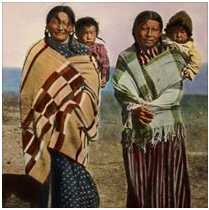 Old
Color Photos of Native Americans collected by Paul Ratner "While making
Moses on the Mesa, a film about a German-Jewish immigrant who fell in love with
a Native-American woman and became governor of her tribe of Acoma Pueblo in
New Mexico in the late 1800s, I developed a passion for researching old photographs
of indigenous people... Please enjoy this first collection of colorized photos.
If you like them, you can find many more at our
historical and photographic archive on Facebook." Click the link or
log on to Facebook - Moses on the Mesa.
Old
Color Photos of Native Americans collected by Paul Ratner "While making
Moses on the Mesa, a film about a German-Jewish immigrant who fell in love with
a Native-American woman and became governor of her tribe of Acoma Pueblo in
New Mexico in the late 1800s, I developed a passion for researching old photographs
of indigenous people... Please enjoy this first collection of colorized photos.
If you like them, you can find many more at our
historical and photographic archive on Facebook." Click the link or
log on to Facebook - Moses on the Mesa.
The Opium Wars In the 1800s, Britain fought two wars in China over opium. The British used military force to smash Chinese government resistance. China was forced to buy opium from British merchants, who sent vast quantities of opium into China. Millions of Chinese became opium addicts. This was like drug lords attacking your country and winning, and then ordering your country to buy their drugs! Click on the link for the nasty details.
Yes, this actually happened.
Nine
Places Where You Can Still See Wheel Tracks from the Oregon Trail Article
by Jennifer Billock on Smithsonianmag
"The legendary trail has carved itself into American history—and,
in some places, into the earth itself"
Rut traces amight be long and flat like the 1,000 feet of trail ruts near Rock
Creek Station (Fairbury, Nebraska),
or the short but five feet deep Guernsey Ruts (Oregon Trail Ruts National Historic
Site in Guernsey, WY), or the
steep and rocky one mile of ruts cut into a cliff at Biggs Junction, Oregon.
See these and more at this site.
Can you imagine what it must have been like?
16
Iconic Landmarks on the Oregon Trail
"The many forts, rocks, springs and other landmarks
along the Oregon Trail kept settlers from losing not
just their direction, but their hope as well."
Detailed discussions of each landmarks on the trail,
kind of reads like a travel site. Colorful characters
and places. This is a big and very educational site.
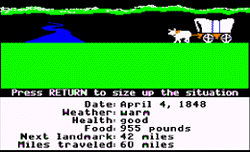 Oregon
Trail for Elementary Schools Arguably the best Oregon Trail site.
Oregon
Trail for Elementary Schools Arguably the best Oregon Trail site.
Plenty of information and links. Comprehensive overview of life on the Trail.
William has a broken arm. You have died of desentery.
History
of the Oregon Trail and Pioneer
Families of Oregon - from End
of the Oregon Trail Anything you would ever want to know about the Oregon
Trail, the rival trails, some of the families who traveled them, and much more.
This huge site could be and should be the source of many K-12 lesson plans.
You should have bought more baking soda saleratus. You do not
have an extra wagon wheel, so you must trade for one.
Oregon Trail Links A large list of links to other OT sites. If you continue hunting in this area, game will become scarce.
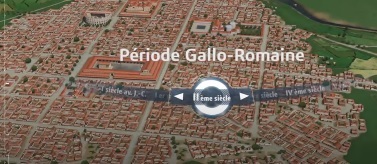
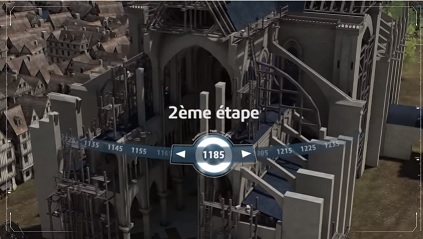
Enjoy the interactive 3-D experience and visit the long-gone
buildings and places of Paris across the ages. See Paris as
the home of the Parisi tribe of Gauls. At 1:00 in the video
a trophy shrine is shown, with cow skulls instead of human
heads (Celts were head hunters.).
Next is Roman Paris with temples, baths, a colosseum,
and an amphitheatre. The Roman city is much bigger
and more sophisticated than the Gaulish town.
Also shown in time lapse are the Louvre, Notre Dame
Cathedral, the Bastille, and the Eiffel Tower. 12:58 video.
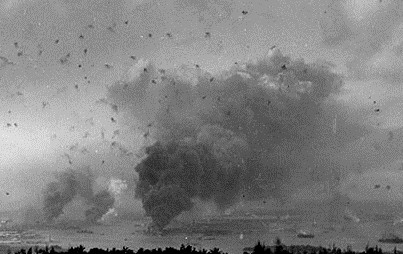
Graphic-filled detailed layout of the attack
Japanese Navy hand drawn map of damage to ships used to tally the hits
Attack
on Pearl Harbor Pictures is a well organized photo gallery, again from US
Navy archives.
Farther down the page is Events
leading up to December 7, 1941 and the Attack on Pearl Harbor.
If students want to know why it happened, this is a good material source, even
though it has many grammatical errors. This section includes the text of FDR's
"Day of Infamy Speech".
Pearl Harbor - Then and Now Ten articles about different aspects of the attack, from conspiracy theories to the story of the 14 Army Air Force fighter pilots who managed to take off from various airstrips to fight the Japanese.
Pigments through the Ages "Pigments are the basis of all paints, and have been used for millennia. They are ground colored material. Early pigments were simply as ground earth or clay, and were made into paint with spit or fat. Modern pigments are often sophisticated masterpieces of chemical engineering. This exhibit includes most important pigments used through the early 20th century." Explore timelines, a pigment catalog, history of different colors, different artist paints, how to mix paint, make your own painting, etc. One of many sites at WebExhibits.
Pirates for Kids from Mr. Nussbaum "features Pirate Biographies, Stories, Games, and Activites for Kids." Nine sections, for kids grades K - 6. Pirates of the Carribean, Barbary Pirates, Famous Pirates, Pirate Flags, Pirate Vocabulary, Interactive Pirates, Explorers, and two math games: Place Value Pirates, and Decimals of the Caribbean.
![]() History
of the Caribbean Pirates: 10 Things You Should Know
History
of the Caribbean Pirates: 10 Things You Should Know
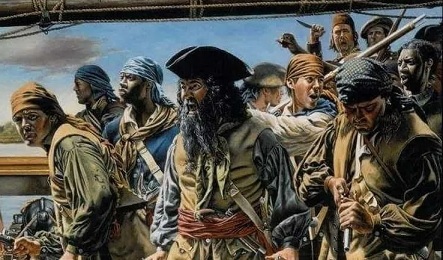
Image: Tampa Bay Online
This site concentrates on 17th-18th-century Caribbean pirates,
and does a good job of it. Well-written with plenty of art, its
a good resource.
Pirate
Activities for elementary students. Here are dozens
of pirate-based activities of every kind. At the top of the
page is the The
Pirate Unit Study They Will Beg to Do!
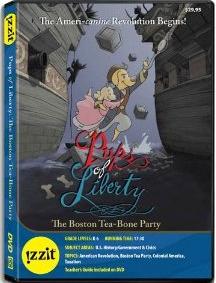 Pups
of Liberty: The Boston Tea-Bone Party
Pups
of Liberty: The Boston Tea-Bone Party
is a teaching DVD from izzit.org, makers
of creative educational DVDs covering a wide subject area. The people of izzit
asked GSFK to review the DVD, and this is our take on it: Pups of Liberty is
a 17:30 long, very well done, professionally voice acted video about the events
culminating in the Boston Tea Party. "The Boston Tea-Bone
Party tells the story of the founding of the Sons of Liberty and the Boston
Tea Party, but with the real people of history portrayed by cats and dogs." The colonials ("Spaniel Adams", "Paul Ruffere"),
and the British ("Royal Tomcat") come across as believable characters.
"No Taxation Without Representation" becomes "No Laws Without
Paws".
This video will hold elementary students' attention and keep them interested in the dramatic events of the times. A little girl dog is the heroine and the "kid focus", but she's definitely an active member of the group. Dogs and cats portraying actual characters speak and act as the real people did. Obviously it's a bit simplified but the events and ideas are covered and explained. There is a pretty good companion web page for kids here. It covers the historical people, places, and events; has a coloring page, and a section on the making of the video. We all thought the DVD well worth the price. It makes a valuable supplement to any elementary classroom and school multimedia resources.
Pups of Liberty: The Dog-claration of Independence The Pups are back in a new 16:19 video! After the Boston Tea-Bone Party, the Pups of Liberty continue to assert themselves against Catland. But the Royal TomCat refuses their requests for representation in the government and issues orders that make life miserable in the 13 Ameri-canine colonies. Witness Paul Ruffere’s famous midnight run to warn the MinuteMutts at Lexington and Concord. Join Anne Kennel and Bonejamin Franklin in Philadelphia. Be there as Thomas Jefferhound writes, and the Continental Congress votes on, the Dog-claration of Independence, starting the Revolutionary War and putting America on the path to freedom. “Give me liberty, or give me dog-breath!” – Pawtrick Henry
Primary Documents in American History From the Library of Congress, this site covers the Declaration of Independence, the U.S. Constitution, the Bill of Rights, the Federalist Papers, documents from the Continental Congress and the Constitutional Convention, 1774-1789, and has a Guide to American Historical Documents Online. There is nothing like reading the original documents!
REVOLUTIONARY WAR: Birth Of A Nation "Welcome to Historycentral's Revolutionary War site.This is the most complete site on the web on the Revolutionary War. The section on the 'Causes of the War' traces the events that led to the American Declaration of Independence. The 'Battle' and 'Main Event' sections tell the story of all the major battles of the war. Many battle entries come with a narrated multimedia presentation that last up to three minutes. A NEW SECTION chronicles many of the major legends and myths of the war. Each story comes with the written text as well as a multimedia presentation; perfect for students of all ages. For those who want to learn more, we have added sections on the Economics, Daily Life and Arts of the period. Our site includes extensive first-hand accounts of battles, along with many other primary source documents. Our Student Guide lists the important terms from this period. Our Teacher's Guide includes many lesson plans with resource materials and ideas on how to teach the American Revolution."
Sailing Into Slavic Lands: The Origins Of The Rurik Dynasty
The history of Norse presence in the territories of modern Russia,
Belarus, and Ukraine, begin quite early in the Viking Age.
"The Vikings were skilled sailors and navigators from Scandinavian lands who used
their naval skills to explore new lands and trade across the seas and oceans, but also
to wage war and vicious raiding and plundering. They dominated the early medieval
period, known as the Viking Age, and were directly responsible for some of the key
developments in that period, shaping the world as we know it today. From England
and Ireland, to Normandy, Iceland, and Greenland too, these fierce Norsemen sailed
the seas and waged war. But did you know that they also sailed to the lands of the
Slavs, creating an early medieval state from which Russia, Ukraine, and Belarus would
form in the modern age? That important Slavic state was the Rurik dynasty. And yes,
you guessed it, they were of Viking origin!" Complete with maps so students can
understand how vast the area is.
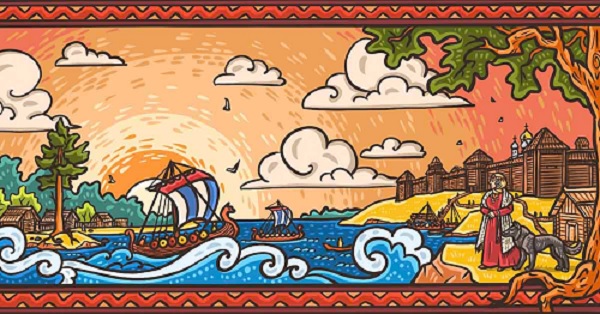

Look up Maidenek, Holocaust

Sid Lapidus '59 Collection on Liberty and the American Revolution from the Princeton University Digital Library. (High school AP and college-level, mostly.) Over 150 original documents from the Revolutionary and Early Republic eras, that you can read online! Thomas Paine is in here among many others. Great for secondary history teachers, research, and for the truly scholarly, the joy of reading from the primary source!
South Dakota History
for kids. This is the official South Dakota 4th Grade state history unit.
Covers prehistory to modern times.
SquinchPix Image Resource - "An Archive of European Imagery" Utterly astounding. Many thousands of artifacts, sculptures, paintings, castles, churches, temples, dishes, jars, ancient helmets, Minoan buildings, Pompeii, cathedrals, etc etc etc. All labelled by date made/built and location.
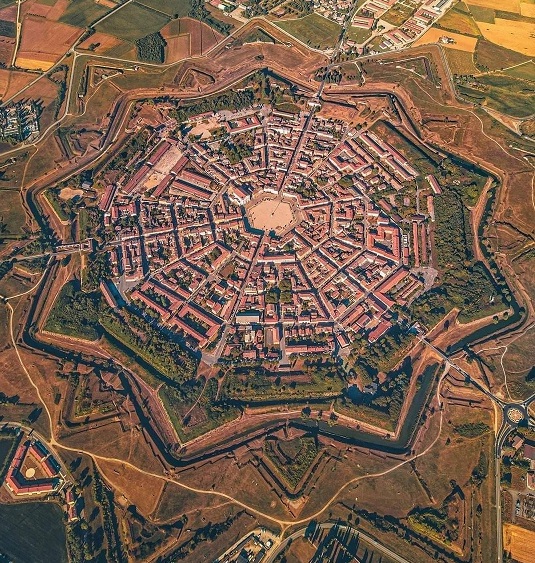
Teaching With Documents: Lesson Plans from the National Archives (U.S.). "This section contains reproducible copies of primary documents from the holdings of the National Archives of the United States, teaching activities correlated to the National History Standards and National Standards for Civics and Government, and cross-curricular connections. Teaching with primary documents encourages a varied learning environment for teachers and students alike. Lectures, demonstrations, analysis of documents, independent research, and group work become a gateway for research with historical records in ways that sharpen students' skills and enthusiasm for history, social studies, and the humanities." There are plenty of .pdf reproducible worksheets, too. Lessons are in eight sections, spanning a period from 1754 to the present day. There are also State & Regional Education Resources for many (not all) states.
Technology and Social Science from SCORE History/Social Science is a whole section on technology integrated into Social Science - with its own lesson plans and ideas for teachers!
![]()
These Appalling Images Exposed Child Labor in America
14 photos from 1911-1912. Things did not change
until the 1930s.
"The Industrial Revolution brought not only
new job
opportunities but new laborers to the workforce: children.
By 1900, at least six percent of all American workers
were under the age of 16. For employers of the era,
children were seen as appealing workers since they
could be hired for jobs that required little skill for
lower wages than an adult would command.
Their smaller size also allowed them to do certain
jobs adults couldn’t, and they were viewed as easy
to manage."
 TimeMaps
specialise in map-based history timelines.
TimeMaps
specialise in map-based history timelines.
TimeMaps' FREE interactive World History
Atlas is the most comprehensive history atlas on the internet. Inside you
will find over 1,500 maps, well-written historical overviews, depth-articles,
images and much more.
Maps and timelines (timemaps) of every civilization, nation and empire. See
the geographical context, chronology, connections and big pictures of history.
FREE!" Fabulous interactive maps that branch
off fractally, let students explore everything about the history of any part
of the world from 3500 BC (5500 BP) to the present day. A short video
shows some examples. The Atlas
shows relationships between peoples and civilizations using graphics and text.
It's full of information. There are also very good and inexpensive iPad, iTunes,
and Chrome apps for sale, from $1 to $3 that we saw, and at least one (The Black
Death) for £1.99. Are the apps worth it! In a word, yes! Our historian
was nearly drooling. They also have available various teaching resources and
materials.
Popular Topics Click & grab the big orange button, then slide the
big orange button to see 13 interactive history timelines for different parts
of the world.
This site is everything it claims to be! Enough! Go see it for yourself!
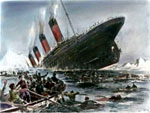 Titanic - Titanic Centennial
1912 - 2012.
Titanic - Titanic Centennial
1912 - 2012.
Our page of links about the history of the
tragic 1912 voyage of the RMS Titanic.
Tradesmen in Colonial America from Pocantico Hills School. "...the Colonists had little to export as trading partners with England, so they had to make what they needed to survive. Eventually they had enough money to pay those skilled craftsmen to make what they needed. You are about to meet some of these tradesmen. We hope you enjoy visiting this period in our history." What did these tradesmen and craftsmen (& women) make? Find out about 15 different trades, from shoemakers to doctors to milliners. Check out the Activities and Links as well. Learn about even more tradesmen, such as brickmakers, gunsmiths, apothecaries, weavers, and more at the Colonial Williamsburg site. What did a cooper make, anyway? What's a wainwright?
Trail
Of Tears Official title: "The Trail Of Tears: Government-Approved Ethnic
Cleansing That Removed 100,000 Native Americans From Their Ancestral Lands"
By Daniel Rennie, in All That's Interesting.
"The Trail of Tears refers to the perilous journey of the 'Five Civilized
Tribes' of the Southeast who were forced by the U.S. government from their ancestral
homelands to a designated zone in the west." Plenty of graphics, maps,
and pictures detail the Indian Removal Act. "up to 100,000 Native Americans
were relocated and over 15,000 lost their lives". They also lost their
homes and their property.
Traitors, Seamstresses, and Generals: Voices of the American Revolution American Revolution ThinkQuest site. Well organized, tons of information. Fits very well with any classroom study of the Revolution. Packed with resources and activities. Succinctly stated: One of the best ThinkQuests we have ever seen.
U.S. Constitution for kids, from usconstitution.net. Separate explanations of the Constitution for: Kindergarten - 3rd Grade, for 4th - 7th Grade, and for 8th - 12th Grade. There is also a Teacher Guide to the material.
Happy Fourth! Did you know that mrnussbaum.com has the most extensive
United States history section for kids on the entire internet?
Explore our nation's great activities and enjoy hundreds of interactive or printable
activities by clicking on the painting above!
U.S. Presidents Here's a valuable site with amazing amounts of information about all 43 U.S. Presidents! Click on any portrait in the matrix of 43 and read the facts. "Currently, U.S. Presidents offers brief overviews of the 43 presidents by way of outlining the major points taken from the following three areas of each president's life: Early Life/Pre-presidency, Presidency, and Post-presidency/Legacy." J.W. Smith, the creator and curator of this website, plans to expand it to include Vice-Presidents, First Ladies, and much more. You should read over his About section to find out more about that and the site. While you're there, check out Roosevelt! Thanks to J. W. Smith for the email.
US Presidents List Lists all US Presidents and Vice Presidents (wow) with links to tons of facts about them. A good gotta-have source of information.
Victorian Britain from BBC Primary History. Be a kid in the time of Victoria! Rich kids were warmly dressed, well fed, and went to school. Poor kids wore rags, were half starved, and went to work as coal miners and factory workers. See their toys and how kids lived in this split society. Check out the Activities and the Fun Facts, too.
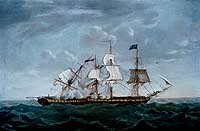 USS Constitution official
home page. Learn about this famous frigate's history, and take a Virtual
Tour of the recently restored ship. Living history.
USS Constitution official
home page. Learn about this famous frigate's history, and take a Virtual
Tour of the recently restored ship. Living history.
USS Constitution fights HMS Java off the coast of Brazil. War of 1812 - one of several spinoffs of the Napoleonic Wars.
Ultimate History Quiz History Channel's excellent American History Quiz! Play single player, multi player, or against friends. Ten questions, choose your level of difficulty. May be addicting. Best for 4th grade and up.
War of 1812 Our big, special section about the War of 1812! It's a big page! Click here to start the adventure!
Watch Paper Ships and Vikings Set Sail on a Stop Motion Adventure 4:00 NatGeo video "You might find yourself in similar territory watching this intricate short, which tells the story of a boy learning the Viking method for building a ship, then setting sail on an ocean voyage. Our animators brought this ancient world to life using only paper! (Want more? Click here to watch their paper history of London.) " Detailed description of how to build a Long Ship.
Watch the United States Grow This animated gif created by redditor Anthony Vincent (we can't show his reddit name on a kid site), lets you watch the expansion of the USA from 1789 to 1959 (question for students - Why 1959?). States, territories becoming states, treaty effects, the Mexican and Civil Wars, the California and Texas Republics joining as states, and the stealing of the Kingdom of Hawaii are all here.* You'd better not blink - this is VERY fast. Perhaps teachers could assign groups of student to watch different sections of North America? * Missing are American Samoa, Guam USA, Puerto Rico USA, the Virgin Islands USA, and small atolls & rocks in the Pacific. Well, hey, you can't have everything!
We
Choose The Moon is an interactive experience recreating the historic Apollo
11 mission to the Moon in real time. Once where only three men made the trip,
now millions can. Live event begins 8:02 AM EDT July 16, 2009, with launch at
9:32 a.m., exactly 40 years after Apollo 11 lifted off.
Were the Middle Ages Dark? 5:46 video. There is no period in history more misunderstood than the Middle Ages. Providence College Professor of English, Anthony Esolen, vividly demonstrates why the "Dark Ages" would be better described as the "Brilliant Ages." His debatable points would make a good springboard for discussions in an AP class.
What childhood was like before labor laws This article from Upworthy was titled "These photos and stories reveal what childhood was like before U.S. labor laws." "For centuries in the United States, child labor was all too common. Despite efforts from educators to encourage primary school, an immigration boom in the latter half of the 19th century resulted in a new pool of child workers. The influx of low-earning, compliant young laborers coincided with the rapid expansion of industrial positions in mills and factories. Children worked long hours, often in cramped, dangerous conditions, to help support their families."
Out of 5,000 + photos in the National Archives, here are 14 with typical situations of kids working hard for tiny wages.
The Great Depression, the Child Welfare Act of 1938, and automation finally did away with most of the child labor jobs. See the photos and read the stories.
![]()
“Whose Land Do You
Live On?” Reminds Americans Colonization
Happened in Their Backyards
First Peoples populated America long before Europeans arrived
to stake their claim. We have largely forgotten this legacy.
A mapping tool is looking to change that.
The Swashbuckling History of Women Pirates from Smithsonian magazine online. "When women roamed the high seas in search of fortune, freedom, and sometimes revenge." This page wants to make sure the newly discovered history of women pirates does not get re-buried. A woman historian named Laura Sook Duncombe wrote a book about them - Pirate Women: The Princesses, Prostitutes, and Privateers Who Ruled the Seven Seas Everyone knows about Mary Read and Anne Bonny. What about Ladgerda, Grace O’Malley, the great Chinese woman pirate Cheng I Sao, Queen Artemisia of ancient Greece, Lady Mary Killigrew, the Moroccan pirate queen Sayyida al-Hurra, and many more? “I wanted something to point at as incontrovertible truth that women are as much a part of pirate history as men,” Ms. Duncombe said. This is a good read, the interview was done by a female lawyer, which counts, as you will see.
Women's Suffrage from about.com has a good timeline and many links to more information. In the USA, women could not vote until 1920 (Native Americans could not vote until 1924!)
World War 2 from BBC Primary History.
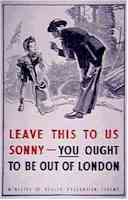
Be a British kid in the time of World War 2 in Britain.
Very good, concise, fact-filled, great to explore this site.
Be a history detective checking out time capsules. Shop
for food in 1943 with a ration book. Explore a wartime
home with bomb shelters. Read letters. Find out what
it was like to be evacuated on a train.
What was The Blitz?

British kids looking up from a trench at German bombers.
Look at their faces. They never did anything to deserve
this war
World War II - The Home Front This is an excellent British site about what it was like to be a child in the UK during World War 2. WW 2 lasted six hard years for the UK, 1939-45. Covers evacuations, The Blitz, bomb shelters, rationing (with Excel game), what women did, propaganda, music of the era. A section for teachers explains the language arts lessons. We need a site like this for American kids, too. This is from the Snaith Primary School in East Yorkshire, UK, and is one small part of their BIG academic site! One downside - links to other UK WW 2 sites are broken.
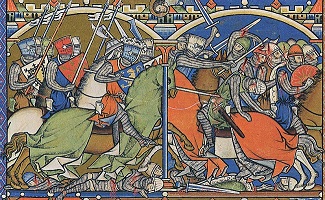 Would
You Survive the Middle Ages? Do you have what it takes to tough out the
Medieval era? Play this interactive game and find out! You'll also learn a lot
about the Middle Ages.
Would
You Survive the Middle Ages? Do you have what it takes to tough out the
Medieval era? Play this interactive game and find out! You'll also learn a lot
about the Middle Ages.
Then play its companion games, Who
Would You Be in Medieval Times? "Queen or Damsel? King or Knight? Take
this fun little quiz to see who you're best suited to be in medieval times :)",
and What
Is Your Medieval Profession? "Have you wondered what you would be if
you lived in the Middle Ages? Would you spend your days walking about the royal
gardens, or sweating at the stable?"
Yorktown Victory Center "On October 19, 1781, the decisive military campaign of the American Revolution culminated with the British surrender to combined American and French forces under the command of George Washington. The Siege of Yorktown effectively ended the six-year struggle of the Revolutionary War and set the stage for a new government and nation." The best parts for online learning are the Yorktown Victory chronology, Yorktown and American Independence, and Militia in the Revolutionary War.
You Are the Historian: Investigating the First Thanksgiving from Plimoth Plantation Online. This is the Plimoth Plantation historical park in Massachusetts that lets you step into the 1600s. Kids will find out amazing things here about Pilgrims and the Wampanoag people. Customs, food, houses, celebrations, and more; guided by two kids, one from each people. A great Flash presentation. Then, from the park's home page, click Learn on the top menu ribbon, go down to Just for Kids. There kids can download coloring pages, learn to Talk Like a Pilgrim, and tons of Homework Help! There is a Virtual Field Trip to the Wampanoag village (Where the people are Wampanoags, not actors), and to the Pilgrim settlement.
![]() to top of page
to top of page ![]()
![]() to Good Sites!
to Good Sites! ![]()
![]() to Science and
Nature
to Science and
Nature
Powered
by ![]() The World's #1 Web Host
The World's #1 Web Host